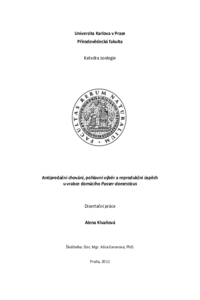Antipredační chování, pohlavní výběr a reprodukční úspěch u vrabce domácího (Passer domesticus)
Antipredatory behaviour, sexual selection and reproductive success in domestic sparrow (Passer domesticus).
rigorózní práce (UZNÁNO)

Zobrazit/
Trvalý odkaz
http://hdl.handle.net/20.500.11956/45328Identifikátory
SIS: 122858
Kolekce
- Kvalifikační práce [19614]
Autor
Fakulta / součást
Přírodovědecká fakulta
Obor
Zoologie
Katedra / ústav / klinika
Katedra zoologie
Datum obhajoby
23. 4. 2012
Nakladatel
Univerzita Karlova, Přírodovědecká fakultaJazyk
Čeština
Známka
Uznáno
Souhrn poznatků disertační práce Biparentální péče u vrabce domácího je nerovnoměrně rozdělena mezi oba partnery. Zatímco samice věnovala více času zahřívání mláďat a častěji je krmila, samec více investoval do obrany hnízda. Rodiče přitom nepřizpůsobovali intenzitu obrany hnízda chování svých partnerů, ani parametrům snůšky. Jen samci měli tendenci bránit dřívější snůšky více, jak předpokládá hypotéza hodnoty snůšky. Příspěvek samce ke krmení mláďat pozitivně ovlivňoval jejich hmotnost. Intenzita obrany hnízda rostla u samců s velikostí melaninového ornamentu, proto předpokládáme, že by ornament mohl sloužit jako signál ochoty samce investovat do obrany hnízda. Potvrzení funkce ornamentu jako signálu rodičovské péče v pohlavním výběru doplňuje závěry recentní metaanalýzy. Naše výsledky ukazují, že velikost ornamentu sice nevypovídá o frekvenci krmení a o čase stráveném zahříváním mláďat, ale koreluje s intenzitou hnízdní obrany, což je složka rodičovské péče, která nebyla metaanalýzou postihnuta. Domníváme se, že tento výsledek není překvapivý, protože korelace velikosti melaninového ornamentu a antipredačního chování je pravděpodobně výsledkem pleiotropního účinku genů řídících melanogenezi, mezi něž patří ovlivnění hladiny testosteronu, který podporuje agresivitu uplatňující se i při obraně hnízda, avšak...
of the thesis Individual components of parental care are disproportionally distributed among the parents in the House Sparrow. While the female broods the nestlings more often and feeds them more frequently, the male defends the nest more intensely. In an experimental study the parents did not adjust their nest defence intensity to behaviour of their partners, nor to brood parameters. Only males tended to defend the sooner broods more intensely, which is in concordance with the "brood value hypothesis". Male contribution to nestling feeding affected their body mass. Male nest defence intensity increased with the size of their melanin ornament. Thus, we assume that the ornament could signal male investment in this component of parental care, while it does not correlate with feeding frequency and time spent by incubation. This output is probably caused by pleiotropic effect of genes regulating melanogenesis, affecting e. g. testosterone plasma level, which is associated with increased agression and lower intensity of other components of parental care as nestling provisioning or incubation. We have also aked the question whether the anti-predator strategy in House Sparrow is stable or depends on the type of the predator. In experiments with three different predator species we showed, that sparrows...
